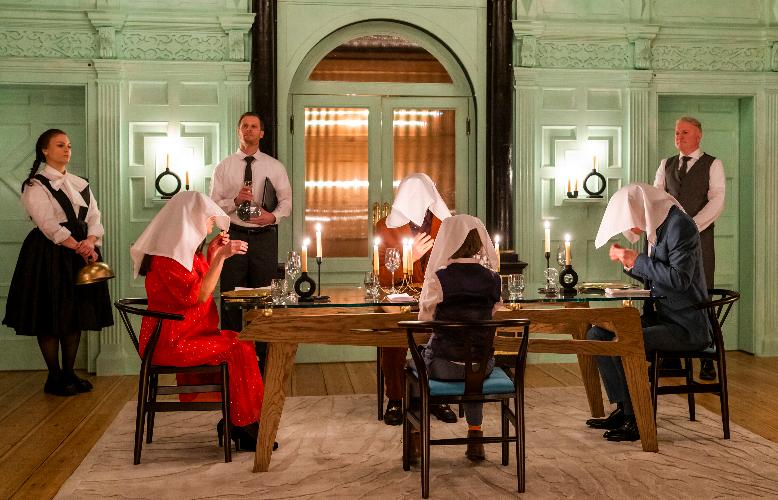For the first time in the history of The Shakespeare Globe, audiences get a chance to experience both the main stage and the smaller Sam Wanamaker Playhouse in just one evening. As the first part of the story takes place at court in Sicilia, the second part in rural Bohemia and then back to Sicilia for the final third, someone at some point must have decided that moving a massive set piece back and forth would have been too much effort; why not just move the audience instead? The switch between the two stages feels so natural, so effortless, that one cannot help but wonder why this is the first time it has ever been done. The candle-lit intimacy of the Sam Wannamaker stage is the perfect setting to showcase the grandeur of King Leonte’s comfortable seat. All the while, the rustic amphitheatre that is the main stage of the Globe is equally ideal for depicting the pastoral fair ground of Bohemia.
In case you need a bit of brushing up on your Shakespeare canon, here is a quick recap: King Polixenes of Bohemia is visiting his dear friend, King Leontes of Sicilia (or Sicily, if you will). He has been a guest at the Sicilian court for nine months and is anxious to return home to his family. However, on the night of his departure, Leontes is taken with jealousy and suspicion of the intimate relationship between Polixenes and Leontes’ heavily pregnant wife, Hermione. How can he be sure that the unborn child is actually his? In a dramatic turn of events, Polixenes is forced to flee for fear of his life and Hermione is imprisoned on charges of adultery. In prison, she gives birth to a girl who is exiled to Bohemia all the while their other child, a son, tragically dies of distress which in turn kills Hermione. Well done, Leontes.
We jump 16 years and now meet a grown-up Perdita, the lost daughter of king Leontes, who has been raised by shepherds. As faith will have it, she meets and falls in love with Polixenes’ son, Florizel. The bohemian king, thinking her a mere shepherd’s daughter, condemns the union and the two flee to Sicily to seek refuge at the court of King Leontes. We shall leave the summary here to avoid any major spoilers but rest assured that the drama is far from over.
The play opens with an ominous ripple of strings seeping down from a balcony above the small, candle-lit stage as King Leontes enters with his wife, son and life-long friend Polixenes, king of Bohemia. All are smartly dressed in modern attire; Queen Hermione in an elegant red dress is noticeably matching not her husband but their guest, Polixenes. Whether this is a not-so-subtle piece of foreshadowing of the events about to unfurl or rather a snide comment on her true loyalties from the costume designer, should be for the audience to decide.
From the get-go, the team of actors show an excellent mastery of the notoriously tricky Shakespearean dialogue. Stand-out performances are Sergo Vares as Leontes and Bea Segura as Hermione. Vares’ menacing demeanour and eventual descent into jealous madness is a bone-chilling watch and a stark contrast to Segura’s poised acceptance of his unfair judgment.
While the first and third act are beautiful representations of how Shakespeare is respectfully brought into the 21st century, the second act struggles with wanting too many things at the same time. Culling a few characters and holding back on the desperate attempts at engaging the audience with humour would have left the needed space for a bit more character development. In many ways act two feels like a completely different play altogether.
That being said, the way members of the Soldier’s Arts Academy (a non-profit organisation that gives former military personnel a way into the arts) are utilized as people of Bohemia for act two is a clever device that lifts the play to a larger scale. In the end, The Winter’s Tale is a fresh take on an absolute classic and it is a safe bet if you want to experience a little Shakespeare but worry that the style and pace will have you dozing within the first few minutes.
It runs until 16 April. Tickets: here.
Review by: Julie Renata Photos: Tristram Kenton


